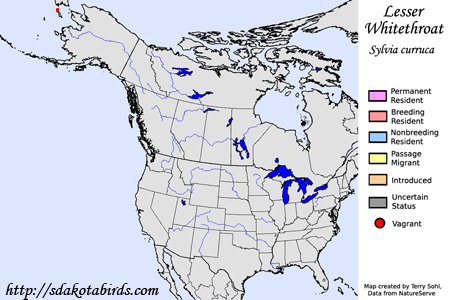| Length: 5 inches | Wingspan: 7 inches | Seasonality: Non-resident in South Dakota |
| ID Keys: Gray or grayish brown upperparts, dull white underparts, darker facial mask, white outer tail feathers | ||
 The
Lesser Whitethroat is an Old World species that breeds in much of Europe and
central Asia, with a winter range in parts of North Africa, the Middle East,
and southern Asia. In North America, they are only extremely rare
vagrants, with a sighting on St. Lawrence Island in the Bering Sea.
They are rather plain in appearance, with both males and females having very
similar plumage.
The
Lesser Whitethroat is an Old World species that breeds in much of Europe and
central Asia, with a winter range in parts of North Africa, the Middle East,
and southern Asia. In North America, they are only extremely rare
vagrants, with a sighting on St. Lawrence Island in the Bering Sea.
They are rather plain in appearance, with both males and females having very
similar plumage.
Habitat: Found in a variety of semi-open habitats with shrub and scrub habitats, including hedgerows, shrublands, woodlands with shrubby undergrowth, and arid scrub lands.
Diet: Feeds mostly on insects and spiders, but they will also occasionally feed on fruits and berries. Fruits and berries are mostly consumed in the fall, prior to migration. Also will sometimes feed on nectar.
Behavior: Fairly secretive, often staying in thick shrubbery and forest undergrowth.
Nesting: The nest is a cup of twigs and grasses, lined with finer matrial. The female lays between 4 and 5 eggs, and both parents help to incubate the eggs. Both parents help to feed the young. The young leave the nest after about 2 years.
Song: The song of a Lesser Whitethroat is a series of rapid, rattling notes.
Migration: Breeds in Europe and central Asia. Strongly migratory, wintering in northeast Africa, the Middle East, and India.
Interactive eBird Map: Click here to access an interactive eBird map of Lesser Whitethroat sightings
Similar Species: Extremely rare vagrant to North America, with a sighting on St. Lawrence Island in the Bering Sea. Rather plain plumage, could possibly be confused with a number of similarly dull-plumaged birds.
Conservation Status: Populations are very widespread across Europe and Asia, and there are some indications that populations are increasing. The IUCN lists the Lesser Whitethroat as a species of "Least Concern".
Further Information: 1) Royal Society for the Protection of Birds - Lesser Whitethroat
2) British Trust for Ornithology - Lesser Whitethroat
3) BirdGuides - Lesser Whitethroat
Photo Information: Photo taken by Sergey Yeliseev - July 23rd, 2011 - Near Moscow in Russia - Photo licensed under Creative Commons Attribution NonCommercial NoDerivs 2.0 Generic License.
| Click below for a higher-resolution map |
 |
| South Dakota Status: Non-resident in South Dakota |
Additional Lesser Whitethroat Photos (coming soon!!)
